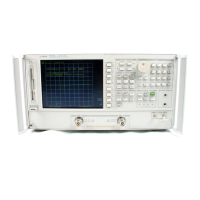Alternate and Chop Sweep Modes
.
../
.,./_.....,.;
.,,.
.:../
/
.,
. . . . .
.,.,......
_..
,,,;;;;..;
:
<..<<r-.’
you
can
select
the
~~~~~~~~~~~.~,.
or
,j&“&&>;.:
~&;j$
softkey
titl&,
the
Come,-&on
More
.
..A
.:::
..,..,..,,
:....;...;
/; . . . . . . . . . . . . . . . /./...,...~ . . . . . . . .
..::.......,..
menu to activate either one or the other sweep modes. For information about sweep types,
refer to “Sweep Type Menu,”
located earlier in this chapter.
Alternate
“~“L’:::~:
:....
..-
:..
,:,,,,,,,.
‘::
,,,,
.:.,.,.
~~~~~.;.~A1~~~~~~~.
measures
only
one
input
per frequency sweep,
h
order
to
reduce
../::::.~~~~._i_;,,.:
,,,,.
s
..,.
;~;~~....:~~~~...ili..
.
.
.
.
..~........;;;...;:;;~;..;~~::::....:
unwanted signals, such as crosstalk from sampler A to B when measuring B/R. Thus, this mode
optimizes the dynamic range for all four S-parameter measurements.
The disadvantages of this mode are associated with simultaneous transmission/reflection
measurements or full two-port calibrations: this mode takes twice as long as the chop mode to
make these measurements.
Chop
.i:~~~~~.:.~~~..,;,.
,~:,~,<~:
/
....:..:.:.:~~~.,.~~.~,,
I
;...
~~~~~~~~
&
is
the
default measurement mode. This mode measures both inputs A and B
during each sweep. Thus, if each channel is measuring a different parameter and both channels
are displayed, the chop mode offers the fastest measurement time. This is the preferred
measurement mode for full two-port calibrations because both inputs remain active.
The disadvantage of this mode is that in measurements of high rejection devices greater than
85
dl3,
such as
tilters
with a low-loss passband, maximum dynamic range may not be achieved.
Figure 6-57 shows the
a2termate
sweep mode (bold trace) overlaying the chop sweep mode in
a band-pass filter measurement. Note the difference in the crosstalk levels between the two
modes
Figure 6-57. Alternate and
Chop
Sweeps Overlaid
6-106 Application and
OperationConcepts

